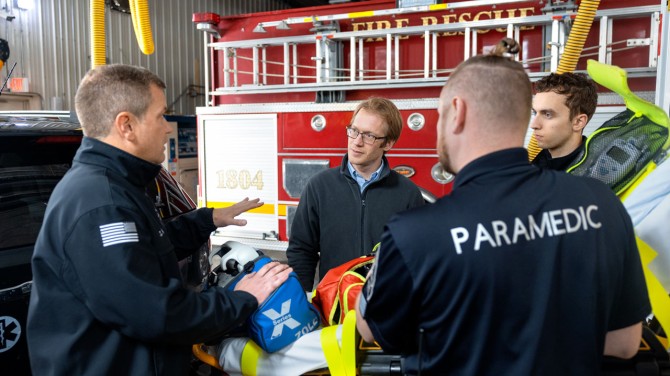Costs, volunteer demands strain rural ambulance services
By James Dean
For nearly 30 years, Kathy Mix proudly supported neighbors outside Ithaca as an advanced emergency medical technician for Slaterville Ambulance.
But at the close of her shift at midnight on Dec. 31, 2015, Mix made the ambulance’s final call to local dispatchers: “Fifteen-Fifty-One signing off and will be indefinitely out of service,” she radioed.
Rising costs, difficulty recruiting volunteers and increasingly stringent certification requirements had led officials to disband the all-volunteer service – a scenario challenging rural communities across upstate New York and beyond, new Cornell research warns.
“What’s happening is really a slow-motion train wreck in terms of one of the basic functions of our society,” said Ben Carver, a Cornell Institute for Public Affairs (CIPA) student and deputy mayor of the Village of Trumansburg, where he oversees EMS operations. “People generally expect that an ambulance will come if you call one.”
Carver led a student team from CIPA – part of the Cornell Jeb E. Brooks School of Public Policy – that analyzed rural EMS services on behalf of municipalities in Tompkins County.
Their report highlights “unsustainable” cost increases – up nearly 80% in Tompkins County since 2016 – growing call volumes and “alarming” trends in response times. Recommendations range from county action to strengthen the pipeline of EMTs and paramedics to, most importantly, state funding support.
The work is raising awareness among local and state policymakers about the strains on rural communities for whom limited ambulance service and half-hour response times could be a life-or-death matter.
“The report helped bring to more people’s attention the struggles that rural EMS is going through right now,” said Justin Vann, emergency services and fire coordinator for the Tompkins County Department of Emergency Response, which provided call data for the CIPA analysis.
Assemblymember Anna Kelles (D-125th Dist.), a former Tompkins County legislator, said the CIPA report had provided valuable data and informed her proposal to establish a state subsidy for rural EMS services, modeled after one that helps communities maintain roads.
“I like data, I like analysis, and I now have it,” Kelles said. “We need to think about EMS differently.”
Earlier, the research team had encouraged local leaders to pass resolutions supporting a proposal by state Sen. Michelle Hinchey ’09 that led to the creation of a state task force on rural ambulance services.
The new report updates and expands upon work CIPA students completed in 2018 for a local task force established after Slaterville Ambulance’s closure. The engagement took place through “Consulting for Government and Nonprofit Organizations,” a class taught by Dan Lamb, deputy supervisor for the Town of Dryden, which saw its EMS tax double in 2020.
“The research shows there’s a real disparity between the viability of ambulance services in heavily populated urban areas and in rural areas,” Lamb said. “The financial model does not work – and we’re not alone in Tompkins County.”
Moving forward, the study argues, EMS, long perceived as a transport function, must be reframed as a frontline health care service. Local EMS budgets have grown in lockstep with national health care costs, the report shows. Modern ambulances are extensions of emergency rooms – requiring equipment, training and certifications that are more expensive and time-consuming to acquire and maintain. That results in an “inequitable and regressive burden” on rural communities relying on volunteers or trying to pay competitive wages, according to the research.
The analysis also emphasizes the interdependence of highly fragmented local EMS agencies that back each other up through mutual aid agreements. After Slaterville Ambulance closed, Tompkins County’s network redistributed resources to support that area. But the average response time countywide increased by roughly a minute – and nearly 10 minutes in one community – as call volumes grew.
“The resilience of our EMS network is really happening on the backs of individual providers who are being asked to provide more and more and more,” Carver said in a presentation to the Tompkins County Council of Governments, which commissioned the research.
In addition to Carver, the CIPA team included Rebecca McDonald, Yiqun Song, Jiade Wang and Qiuyu Wu.
Before his expected graduation this spring, Carver is continuing to study EMS funding models outside New York state. He’s also trying to determine the population density at which for-profit commercial ambulance services are viable – or where state support could provide rural agencies a lifeline.
He said the issue has broad bipartisan support and is “uniquely solvable.”
Mix, the former volunteer critical care EMT, said she’s encouraged to see momentum building toward solutions that might keep more services like Slaterville Ambulance in business.
“I got into it because I wanted to support my community and help my fellow neighbors,” she said. “If you look at any of the local agencies, they’re all struggling for help.”
Get Cornell news delivered right to your inbox.
Subscribe


